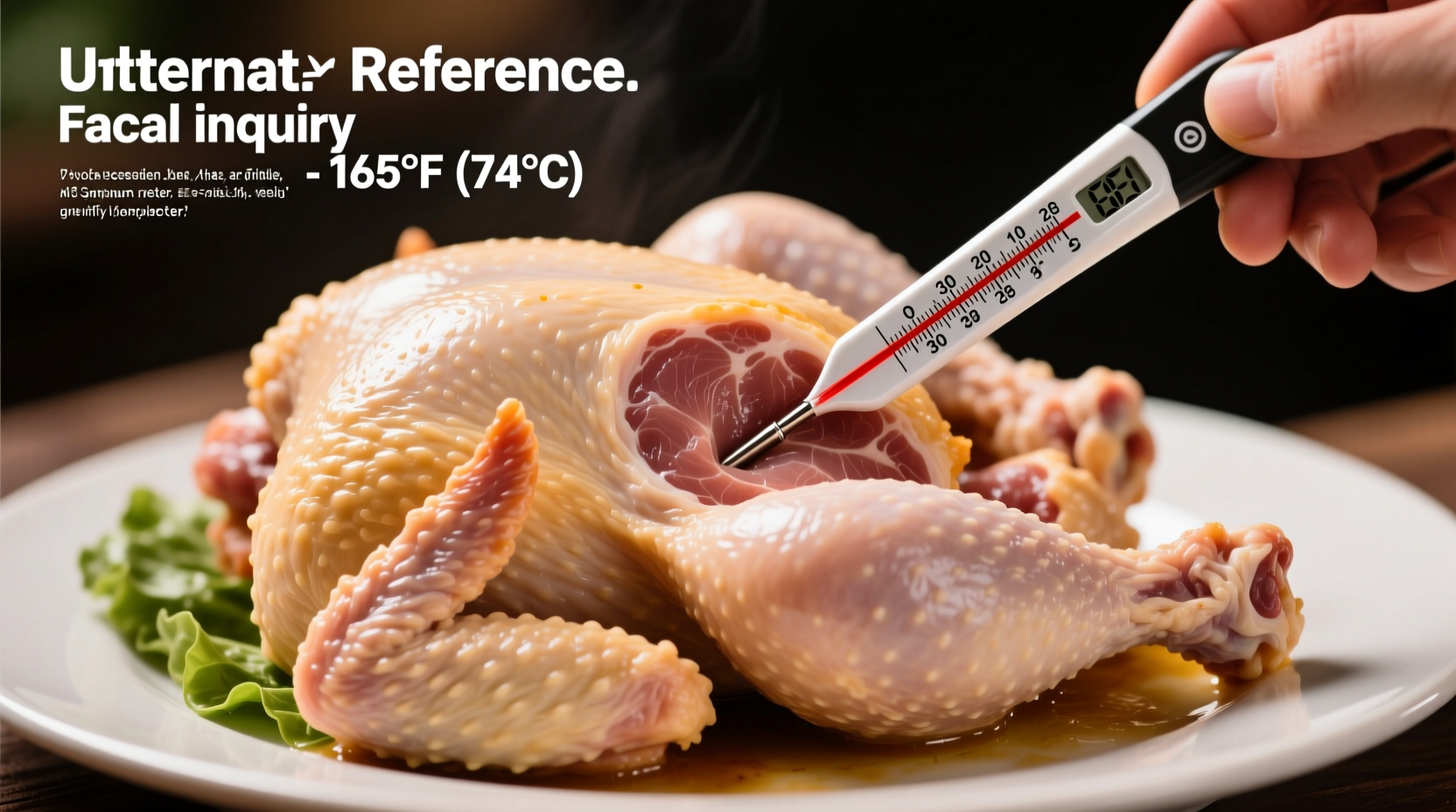Why 165°F Is the Gold Standard for Chicken Safety
When you're standing at the stove with raw chicken in front of you, knowing the exact temperature requirement isn't just helpful—it's essential for preventing foodborne illness. The 165°F (73.9°C) standard isn't arbitrary; it's the temperature at which dangerous pathogens like Salmonella and Campylobacter are instantly destroyed. These bacteria cause millions of food poisoning cases annually, with chicken being a primary vector.
Unlike some cooking guidelines that offer ranges, poultry safety has one non-negotiable benchmark. The Centers for Disease Control and Prevention (CDC) reports that Salmonella causes approximately 1.35 million infections in the United States each year, with chicken products being a significant source. Cooking to 165°F provides a critical safety margin that accounts for uneven heating and thermometer inaccuracies.
How Temperature Requirements Have Evolved
Chicken cooking recommendations haven't always been this precise. Understanding this timeline helps explain why current standards exist:
| Time Period | Recommended Temperature | Scientific Basis |
|---|---|---|
| Pre-1990s | "Cook until no longer pink" | Visual assessment only, highly unreliable |
| 1990s-2006 | 180°F for whole chicken, 170°F for parts | Based on older thermal death point studies |
| 2006-Present | 165°F for all poultry products | USDA research showing instant kill at 165°F |
This evolution reflects improved scientific understanding of pathogen destruction. The current standard balances safety with quality—cooking beyond 165°F unnecessarily dries out chicken, while lower temperatures risk illness.
Measuring Temperature Correctly: The Professional Method
Knowing the target temperature means nothing if you don't measure properly. Here's how professional chefs ensure accuracy:
- Use a calibrated instant-read thermometer - Digital thermometers are significantly more accurate than dial versions
- Target the thickest part - Insert the probe into the deepest muscle area, avoiding bone
- Check multiple spots - Especially with larger pieces like whole chickens or turkey breasts
- Wait 10 seconds - For the reading to stabilize before recording
- Clean between measurements - Prevent cross-contamination by sanitizing the probe

Special Considerations for Different Chicken Preparations
While 165°F remains the universal safety standard, different preparations have specific considerations:
| Chicken Type | Special Considerations | Resting Time |
|---|---|---|
| Whole chicken | Check thigh, breast, and wing joint areas | 15-20 minutes |
| Chicken breasts | Thickest part near the breastbone often cooks slowest | 5-10 minutes |
| Ground chicken | No resting needed; must reach 165°F throughout | None |
| Sous vide | Can cook at lower temps for longer times (145°F/63°C for 30+ minutes) | Immediate serving |
Common Temperature Mistakes Home Cooks Make
Even with the right information, many home cooks make critical errors that compromise safety:
- Testing too early - Checking temperature repeatedly cools the meat and extends cooking time
- Relying on color - Fully cooked chicken can remain pink due to myoglobin reaction, especially in younger birds
- Ignoring carryover cooking - Chicken continues to cook 5-10°F after removal from heat
- Not calibrating thermometers - Many inexpensive thermometers have 5-10°F variance
- Testing only one spot - Uneven heating means some areas may remain undercooked
What If You Don't Have a Thermometer?
While a food thermometer is the only reliable method, these visual indicators can serve as secondary confirmation after you've reached the proper temperature:
- Juices run clear, not pink or red
- Meat is opaque throughout with no translucent areas
- Leg joints move easily when wiggled
- Texture is firm but yields slightly to pressure
Never rely solely on these methods—they're significantly less reliable than thermometer measurements. The USDA recommends always using a food thermometer for poultry.
Global Temperature Standards Comparison
While 165°F is the U.S. standard, other countries have similar but sometimes slightly different requirements:
| Country/Region | Recommended Temperature | Source |
|---|---|---|
| United States | 165°F (73.9°C) | USDA FSIS |
| Canada | 74°C (165°F) | Canadian Food Inspection Agency |
| United Kingdom | 75°C (167°F) | Food Standards Agency |
| Australia | 75°C (167°F) | Food Standards Australia New Zealand |
These minor variations reflect different regulatory approaches but all target the same safety outcome—complete destruction of harmful bacteria.
Temperature Danger Zone: Why Timing Matters
Understanding the temperature danger zone (40°F-140°F) is crucial for chicken safety. Bacteria multiply rapidly in this range, doubling every 20 minutes under ideal conditions. When cooking chicken:
- Never thaw chicken at room temperature
- Cook immediately after marinating
- Don't let cooked chicken sit out more than 2 hours (1 hour if above 90°F)
- Cool leftovers rapidly and refrigerate within 2 hours
The USDA Food Safety and Inspection Service emphasizes that time spent in the danger zone accumulates—during preparation, cooking, and cooling. This is why proper cooking temperature is just one component of food safety.
Professional Tips for Perfectly Cooked Chicken Every Time
As a chef who's cooked thousands of chicken portions, here are my top techniques for combining safety with quality:
- Start with proper thawing - Refrigerator thawing maintains safety while preserving texture
- Bring to room temperature - Let chicken sit 20-30 minutes before cooking for even heating
- Use carryover cooking strategically - Remove from heat at 160°F to reach 165°F during resting
- Rest properly - Tent with foil and rest 5-10 minutes to redistribute juices
- Sanitize between steps - Clean surfaces and utensils that contact raw chicken
Remember: When it comes to chicken safety, precision isn't perfectionism—it's protection. The 165°F standard exists because foodborne illness can have serious consequences, especially for children, elderly individuals, and those with compromised immune systems.











 浙公网安备
33010002000092号
浙公网安备
33010002000092号 浙B2-20120091-4
浙B2-20120091-4